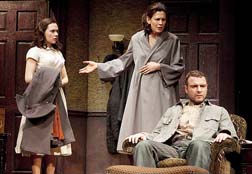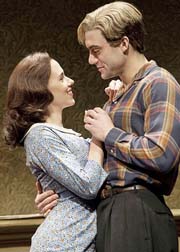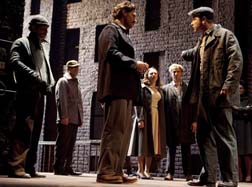Lucy KomisarLive Schreiber gives taut, subtle performance in Miller's "A View From the Bridge""A View From the Bridge."
Arthur Miller's story of the betrayal that tears apart a longshore family in Brooklyn was a metaphor for the treachery of the people who "named names" in the anti-communist witch hunts of the 1950s. Miller was particularly angry at director Elia Kazan, with whom he had worked. In 1956, Miller was subpoenaed by the House Un-American Activities Committee and cited for contempt of Congress for refusing to identify writers he had met at one of two communist writers' meetings he had attended years before. That same year, "A View from the Bridge" opened on Broadway. In this powerful revival directed by Gregory Mosher, we witness the inexorable downfall of Eddie Carbone (Liev Schreiber), a longshoreman, who forgets the sense of honor and loyalty that is the glue that holds together the hard-working Italian community in Red Hook, on the Brooklyn waterfront, where he and his wife Beatrice (Jessica Hecht) live. His self-interest is not the careerism of the film and theater people who betrayed colleagues to HUAC, but jealousy ignited by the illicit passion he feels for his niece Catherine (Scarlett Johansson). Catherine has lived with them since the death of her mother, Beatrice's sister, but the child is now 17 and nubile. Eddie tries to keep her at home so that she can't meet young men. He says he's looking out for her. But there's something else going on. Beatrice warns Catherine that it's not proper anymore to sit on the bathtub in her slip while Eddie is shaving.
The impending crisis is ignited by the arrival of Beatrice's two cousins, illegal immigrants from Sicily, who have left Italy to find work. Such immigrants, known as "submarines," were supported by the Italian community, which found jobs for them on the docks. Marco (Corey Stoll) is stolid and serious; he has come to earn money to support his family, particularly to buy medicine for his children. His brother Rodolpho (Morgan Spector) is a charmer, blonde, a singer, and single. Catherine immediately falls for him. Eddie's hostility to Rodolpho reveals the depth of his obsession with his niece which keeps him from sleeping with his own wife. The lawyer, Alfieri (Michael Cristofer), advises Eddie, "Somebody had to come for her." Schreiber, one of the best actors appearing on the stage today, exhibits a cool surface that slowly disintegrates to reveal the conflagration building below. When he picks on Rodolpho for singing and cooking and making dresses, he explains, "The guy aint right." It's Miller's way of saying "homosexual" for "communist," a ready target. Jessica Hecht and Michael Cristofer, with strong Brooklyn accents that enforce their sense of place, of belonging to Red Hook and its culture, are brilliant in their roles. Cristofer speaks in a slow sometimes staccato voice as befits the local wise man, or perhaps the oracle.
Johansson does well as the naïve Catherine, girlish and unaware of the effect she has. Spector and Solli are excellent as Rodolpho and Marco, the first light-hearted at the life possibilities before him, the other dark and troubled, weighed down by his responsibilities in Sicily. Designer John Lee Beatty recreates the dreary world of the Carbones in their non-descript living room with light brown walls, a round wood table and chairs, and a fake fireplace. The bridge in the title is the Brooklyn Bridge, visible to the north, connecting Lower Manhattan and Brooklyn Heights. In a work that Miller meant to be allegorical, it can be a bridge to and from the rest of the world. Some productions have put the waterfront and distant bridge in the set. Beatty doesn't. He creates a line of rich brown brick tenements, which represents the family's self-enclosed limited world and community. "I want my respect," Eddie declares, but as people from the neighborhood gather around him in the final scene, he appears to have forgotten what their code for earning respect entails.
| lobby | search
| home | cue-to-cue |
discounts | welcome | film
| dance | reviews
| |
||||||




